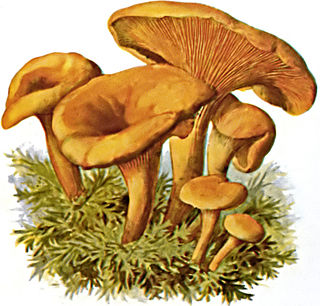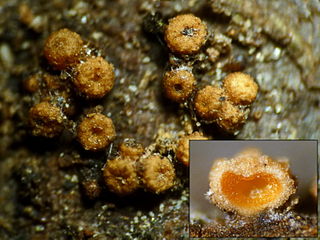Related Research Articles

The Russulales are an order of the Agaricomycetes,. According to the Dictionary of the Fungi, the order consists of 12 families, 80 genera, and 1767 species. According to Species Fungorum, the order contains 13 families, 117 genera, and 3,060 species.

The Pluteaceae are a family of small to medium-sized mushrooms which have free gill attachment and pink spores. Members of Pluteaceae can be mistaken for members of Entolomataceae, but can be distinguished by the angled spores and attached gills of the Entolomataceae. The four genera in the Pluteaceae comprise the widely distributed Volvariella and Pluteus, the rare Chamaeota, and Volvopluteus, which was newly described in 2011 as a result of molecular analysis. The Dictionary of the Fungi estimates there are 364 species in the family.

The Hygrophoropsidaceae are a family of mushrooms that are gilled in appearance but lie within the Boletales. The family contains 18 species within two genera: Leucogyrophana and Hygrophoropsis, with the best-known member being the "false chanterelle", Hygrophoropsis aurantiaca. Hygrophoropsidaceae was circumscribed by French mycologist Robert Kühner in 1980, with Hygrophoropsis as the type genus. Unlike most members of the Boletales, Hygrophoropsidaceae species are saprophytic wood-rotting fungi that cause brown rot in their hosts. The genera Austropaxillus and Tapinella, once placed in this family, are now classified in the Serpulaceae and Tapinellaceae, respectively.

Helotiales is an order of the class Leotiomycetes within the division Ascomycota. According to a 2008 estimate, the order contains 10 families, 501 genera, and 3881 species.

Puccinia is a genus of fungi. All species in this genus are obligate plant pathogens and are known as rusts. The genus contains about 4000 species.

Verpa is a genus of ascomycete fungi related to the morels. Resembling the latter genus in edibility and form, the common name early morels is popular. There are five species in the widespread genus.

The Helvellaceae are a family of ascomycete fungi, the best-known members of which are the elfin saddles of the genus Helvella. Originally erected by Elias Magnus Fries in 1823 as Elvellacei, it contained many genera. Several of these, such as Gyromitra and Discina, have been found to be more distantly related in a molecular study of ribosomal DNA by mycologist Kerry O'Donnell in 1997, leaving a much smaller core clade now redefined as Helvellaceae. Instead, this narrowly defined group is most closely related to the true truffles of the Tuberaceae. Although the Dictionary of the Fungi considered the Helvellaceae to contain six genera and 63 species, genetic analysis has shown that Leucangium, previously classified in this family, is more closely related to the Morchellaceae.

Trametes is a genus of fungi that is distinguished by a pileate basidiocarp, di- to trimitic hyphal systems, smooth non-dextrinoid spores, and a hymenium usually without true hymenial cystidia. The genus has a widespread distribution and contains about fifty species. The genus was circumscribed by Elias Magnus Fries in 1836.

Rhizopogonaceae are a family of fungi in the order Boletales. The family, first named and described by botanists Ernst Albert Gäumann and Carroll William Dodge in 1928, contains 2 genera and 151 species. The genus Fevansia, formerly thought to belong in the Rhizopogonaceae, was found to belong in the Albatrellaceae in a molecular phylogenetics study.
The Hemiphacidiaceae are a family of fungi in the order Helotiales. Although the type genus was originally Hemiphacidium, it has since been renamed to Sarcotrochila. The 26 species in this family are limited in distribution to northern temperate zones.

The Helotiaceae are a family of fungi in the order Helotiales. The distribution of species in the family are widespread, and typically found in tropical areas. There are 117 genera and 826 species in the family.

The Inocybaceae are a family of fungi in the order Agaricales. Members of this family have a widespread distribution in tropical and temperate areas.

The Mycenaceae are a family of fungi in the order Agaricales. According to the Dictionary of the Fungi, the family contains 10 genera and 705 species. This is one of several families that were separated from the Tricholomataceae as a result of phylogenetic analyses. Taxa in the Mycenaceae are saprobic, have a cosmopolitan distribution, and are found in almost all ecological zones. The family was circumscribed by Caspar van Overeem in 1926.

Glyphis is a genus of lichenized fungi in the family Graphidaceae. The genus has a widespread distribution, especially in tropical regions.

The Bionectriaceae are a family of fungi in the order Hypocreales. A 2008 estimate places 35 genera and 281 species in the family. Species in the family tend to grow on plant material, including woody debris, while some species associate with algae, bryophytes, or other fungi.

Phyllotopsis is a genus of fungi in the family Tricholomataceae. The widespread genus contain five species that are predominantly in temperate regions.

The Serpulaceae are a family of fungi in the Boletales order. According to the Dictionary of the Fungi, the family contains 4 genera and 20 species. However, a molecular phylogenetics study showed that the genus Neopaxillus, which was formerly placed in this family, belongs in the family Crepidotaceae in the order Agaricales.

Ramularia is a genus of ascomycete fungi. Its species, which are anamorphs of the genus Mycosphaerella, are plant pathogens. Hosts include Narcissus.

Subulicystidium is a genus of corticioid fungi in the family Hydnodontaceae. The genus has a widespread distribution, and contains seven species.

Leucangium is a genus of ascomycete fungi. The genus was circumscribed by French mycologist Lucien Quélet in 1883. Although classified in the Helvellaceae in the past, molecular analysis indicates it is closely related to the genus Fischerula and Imaia, and therefore must be placed in the Morchellaceae. The genus includes two species, Leucangium ophthalmosporum Quél. and L. carthusianum Paol., and both of them produce sequestrate ascoma, globose to ellipsoidal ascus, and dark olive-colored to grayish green, smooth, fusiform ascospores.
References
- ↑ Fischer A. (1891). Rabenhorst's Kryptogamen-Flora, Pilze – Phycomycetes (in German). 1 (2nd ed.). Leipzig: Kummer. p. 114.
- ↑ Vélez CG, Letcher PM, Schultz S, Powell MJ, Churchill PF (2011). "Molecular phylogenetic and zoospore ultrastructural analyses of Chytridium olla establish the limits of a monophyletic Chytridiales". Mycologia. 103 (1): 118–30. doi:10.3852/10-001. PMID 20943553.
- ↑ Kirk PM, Cannon PF, Minter DW, Stalpers JA (2008). Dictionary of the Fungi (10th ed.). Wallingford, UK: CAB International. p. 239. ISBN 978-0-85199-826-8.